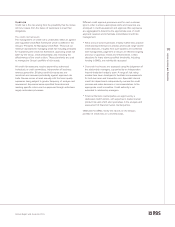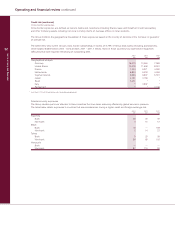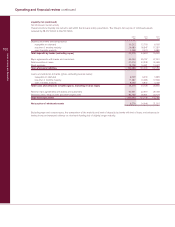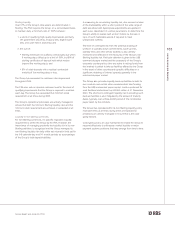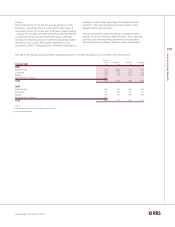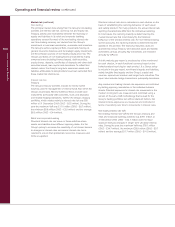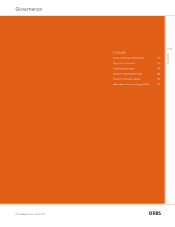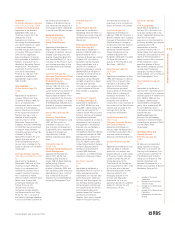RBS 2003 Annual Report Download - page 105
Download and view the complete annual report
Please find page 105 of the 2003 RBS annual report below. You can navigate through the pages in the report by either clicking on the pages listed below, or by using the keyword search tool below to find specific information within the annual report.
103
Annual Report and Accounts 2003
Operating and financial review
Sterling liquidity
Over 51% of the Group’s total assets are denominated in
Sterling. The FSA requires the Group, on a consolidated basis,
to maintain daily a minimum ratio of 100% between:
1. a stock of qualifying high quality liquid assets (primarily
UK government securities, treasury bills, eligible bank
bills, and cash held in branches) and
2. the sum of:
•Sterling wholesale net outflows contractually due within
5 working days (offset up to a limit of 50%, by 85% of
sterling certificates of deposit held which mature
beyond five working days); and
•5% of retail deposits with a residual contractual
maturity of five working days or less.
The Group has exceeded the minimum ratio requirement
throughout 2003.
The FSA also sets an absolute minimum level for the stock of
qualifying liquid assets that the Group is required to maintain
each day. The Group has exceeded that minimum stock
requirement at all times during 2003.
The Group’s operational processes are actively managed to
ensure that both the minimum Sterling liquidity ratio and the
minimum stock requirement are achieved or exceeded at all
times.
Liquidity in non-sterling currencies
For non-Sterling currencies, no specific regulatory liquidity
requirement is set for the Group by the FSA. However, the
importance of managing prudently the liquidity risk in its non-
Sterling activities is recognised and the Group manages its
non-Sterling liquidity risk daily within net mismatch limits set for
the 0-8 calendar day and 0-1 month periods as a percentage
of the Group’s total deposit liabilities.
In measuring its non-sterling liquidity risk, due account is taken
of the marketability within a short period of the wide range of
debt securities held. Appropriate adjustments are applied in
each case, dependent on various parameters, to determine the
Group’s ability to realise cash at short notice via the sale or
repo of such marketable assets if required to meet
unexpected outflows.
The level of contingent risk from the potential drawing of
undrawn or partially drawn commitments, back-up lines,
standby lines and other similar facilities is also actively
monitored and reflected in the measures of the Group’s non-
Sterling liquidity risk. Particular attention is given to the US$
commercial paper market and the propensity of the Group’s
corporate counterparties (who are active in raising funds from
that market) to switch to take up facilities offered by the Group
in the event of either counterparty specific difficulties or a
significant widening of interest spreads generally in the
commercial paper market.
The Group also provides liquidity back-up facilities to both its
own conduits and certain other conduits which take funding
from the US$ commercial paper market. Limits sanctioned for
such facilities totalled less than £4,000 million at 31 December
2003. The short-term contingent liquidity risk in providing such
back-up facilities is also mitigated by the spread of maturity
dates, typically over a three-month period of the commercial
paper taken by the conduits.
The Group has operated within its non-Sterling liquidity policy
mismatch limits at all times during 2003 and operational
processes are actively managed to ensure that is the case
going forward.
Contingency plans are also maintained to enable the Group to
respond effectively to unforeseen market liquidity or major
payment systems problems that may emerge from time to time.


